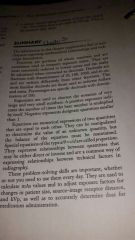![]()
![]()
![]()
Use LEFT and RIGHT arrow keys to navigate between flashcards;
Use UP and DOWN arrow keys to flip the card;
H to show hint;
A reads text to speech;
13 Cards in this Set
- Front
- Back
|
Formula for calculating mAs |
Milliamperage x seconds mAs=mA x s |
|
|
mA |
milliamperage: a unit that represents the rate at which x-rays are produced |
|
|
SID |
Source - image receptor distance: the distance between the radiation source in the x-ray tube and the imaging plane. |
|
|
Inverse square law |
Radiation intensity is inversely proportional to the square of the distance. Original intensity/new intensity = new SID squared/original SID squared |
|
|
How do you compensate for radiation intensity changes when the SID changes? |
mAs is used to compensate for changes in distance. Since the intensity decreases as the distance increases (inverse proportion), the mAs must be increased when the distance increased (direct proportion) |
|
|
Formula for changing mAs to maintain a constant radiation intensity when the distance changes: |
Original mAs/ new mAs = original SID^2/new SID^2 |
|
|
Formula for adjusting kVp for body size: |
Below 85 kVp, an adjustment of 2kVp/cm will compensate for small changes in part size. Above 85 kVp, a change of 3 kVp/cm is necessary. (Only useful for very small variations from normal otherwise it causes significant alteration of image apperance). |
|
|
What is the usual and best choice of factors to adjust when compensating for differences in patient part size? |
mAs |
|
|
Formula for changing mAs based on patient part size: |
For a 2cm increase in patient part size, increase the mAs by 30% (multiply by 1.3) For a 2cm decrease in patient part size, decrease the mAs by 20% (multiply by 0.8). |
|
|
How do you change the scale of contrast on an image? |
The kVp is increased to lengthen the scale of contrast and create a grayer images. The kVp is decreased to shorten the scale of contrast producing a more black and white image. |
|
|
If the kVp is altered to change the contrast, what rule is used to change the mAs to compensate for the change in radiographic density? |
15% rule: To increase contrast, decrease the kVp by 15% and multiply the mAs by 2. To decrease contrast, increase latitude, and lower patient dose, increase the kVp by 15% and divide the mAs by 2. |
|
|
Formula for determining the correct quantity of any drug: |
Dose/strength = volume |
|
|
Chapter 3 summary |

Math problems |

